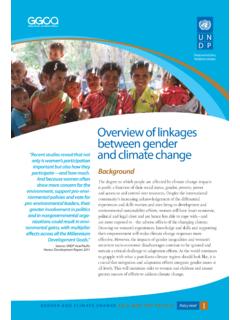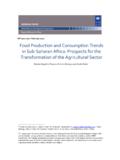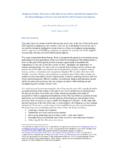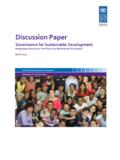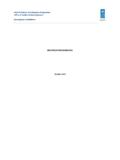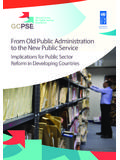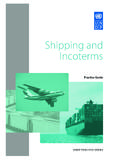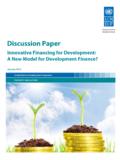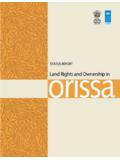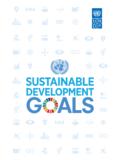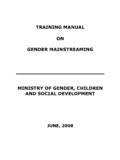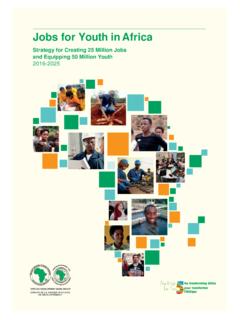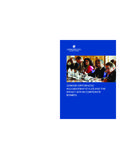Transcription of Gender and disaster risk reduction - undp.org
1 Empowered lives. Resilient nations. Gender and disaster risk reduction Background The recent upsurge in the intensity and recurrence of hydro- meteorological disasters underscores the need for an increased Women bring understanding of the nexuses among disasters, climate change unique experiences and the human impacts of these often intertwined phenomena. Climate change will affect disaster risks in two ways: by and valuable skills increasing the frequency and severity of weather and climate that would benefit hazards and by increasing communities' overall vulnerability disaster risk mitiga- to these hazards (through factors such as ecosystem degradation, reductions in water and food availability and tion and preparedness.)
2 Changes to livelihoods). By recognizing and promoting the unique Disasters tend to hit the poorest and most marginalized capacities of women, demographics the hardest. Women and girls are particularly exposed to climate-related disaster risk they are likely to suffer one can simultaneous- higher rates of mortality, morbidity and economic damage to ly further community their livelihoods. Women bring unique experiences and skills to resilience and advance disaster risk reduction and management, although these skills are often not acknowledged or tapped into sufficiently. Increased Gender equality. awareness of the drivers, pressures, stressors and opportunities associated with climate-related disasters is key to finding smart pathways to reduce and manage disasters.
3 It is therefore G E N D E R A N D C L I M AT E C H A N G E A S I A A N D T H E P A C I F I C policy brief 3. imperative that disaster risk reduction and management strategies are Gender -aware, taking into account both Gender -based vulnerabilities as well as women's unique Disasters pose huge developmental challenges On average, disasters killed more than 70,000 people and affected more than 200 million people per year during the last decade in the Asia-Pacific Climate-related disasters ( storms, heavy rainfalls, floods, droughts, landslides, water stress and heatwaves), unplanned urban development, vulnerable livelihoods and ecosystem degradation could overturn years of progress made towards achieving sustainable development objectives and the Millennium Development Almost 90 percent of deaths in disasters occur in hydro- meteorological There is a mutually reinforcing relationship between climate change and disasters.
4 Climate change increases the intensity and frequency of extreme weather and climate events such as tropical cyclones, floods and Further, the adverse impacts of climate change on livelihoods and ecosystems diminish communities' adaptive capacities and increase their vulnerability to Gender -based vulnerability and exposure to disaster risk is clearly established Although all countries grapple with real and/or potential extreme hazards ( earthquakes, tropical cyclones, floods), some are more vulnerable than others. The Asia-Pacific region, for example, accounted for 90 percent of countries affected by disasters, 65 percent of disaster related deaths and 38 percent of economic damage7 and climate change will likely intensify existing risk patterns in the While disasters pose threats to lives and livelihoods of everyone in their path, they tend to have disparate impacts on particular demographics.
5 This is The differential Gender impacts of hazards Following the 1991 cyclone and flood in Bangladesh, women's death rate was almost five times higher than men's. Warning information was transmitted by men to men in public spaces, but was rarely communicated to the rest of the family. As many women are not allowed to leave the house without a male relative, they perished waiting for their relatives to return home and take them to a safe place. Moreover, as in many other Asian countries, most Bengali women have never learned to swim, which significantly reduced their survival chances during the flood. Source: R hr, U.
6 , 2006 Gender and Climate Change', Tiempo, Issue 59. Available at portal/archive/ 2 Gender AND CLIMATE CHANGE ASIA AND THE PACIFIC. policy brief 3 Gender and disaster risk reduction due to the fact that disaster risk is a function of adaptive capacity' the ability of communities and people to cope with the hazard at In other words, the poor are likely to live under circumstances that make them less likely to survive and recover from a disaster Studies have shown that disaster fatality rates are much higher for women than for men due, in large part, to gendered differences in capacity to cope with such events and insufficient access to information and early For example.
7 Women accounted for 61 percent of fatalities caused by Cyclone Nargis in Myanmar in 2008, 70 80 percent in the 2004 Indian Ocean tsunami, and 91 percent in the 1991 cyclone in Climate change and disasters: Fast Facts . Women and children are 14. times more likely than men to die during a disaster .. There is a direct relationship between women's risk of being killed during disasters and their socio-economic status (defined as access to information, economic resources and ability to exercise personal freedom of choice).. In the 2004 Asian tsunami, women in many villages in Aceh, Indonesia, and in parts of India accounted for over 70 percent of the dead.
8 More women than men died during the 2003 European heatwave. In France, most deaths were among elderly women.. During Hurricane Katrina, most of the people trapped in New Orleans were African- American women and children, the poorest demographic group in the US.. Extreme weather events often create conditions conducive to outbreaks of infectious diseases ( heavy rains can produce insect breeding grounds and contaminate clean water sources; drought can cause fungal spores and spark fires).. In refugee camps, women and girls are exposed to higher risks than men, including through conflict over scarce resources.
9 Compounding this, social strains in such situations aggravate stress levels in the family, which may result in increased incidences of domestic violence.. In some situations, men are disproportionately vulnerable: there were more immediate deaths among men when hurricane Mitch struck Central America, not only because they were engaged in open-air activities, but because they took fewer precautions when facing risks. Sources: Gault, B., H. Hartmann, A. Jones-DeWeever, M. Werschkul and E. Williams, The Women of New Orleans and the Gulf Coast: Multiple Disadvantages and Key Assets for Recovery. Part I. Poverty, Race, Gender , and class', Institute for Women's policy , Research Briefing Paper, 2005; Neumayer, E.
10 , and T. Plumper, The Gendered Nature of Natural Disasters: The Impact of Catastrophic Events on the Gender Gap in Life Expectancy, 1981-2002 , Annals of the Association of American Geographers, issue 97, 1997; see also International Union for Conservation of Nature, available at: ; Oxfam, The Tsunami's Impact on Women', Briefing Note, March 2005; Peterson, K., Reaching Out to Women when disaster Strikes', White Paper, Soroptimist, 2007; Pirard, P., S. Vandentorren, M. Pascal, K. Laaidi, A. Le Tertre, S. Cassadou and M. Ledrans, Summary of the Mortality Impact Assessment of the 2003 Heat Wave in France', Eurosurveillance 10 (7), 2005; United Nations Economic and Social Commission for Asia and the Pacific, Statistical Yearbook for Asia and the Pacific, Thailand, 2011.
